2009 VOLKSWAGEN GOLF jump cable
[x] Cancel search: jump cablePage 322 of 516
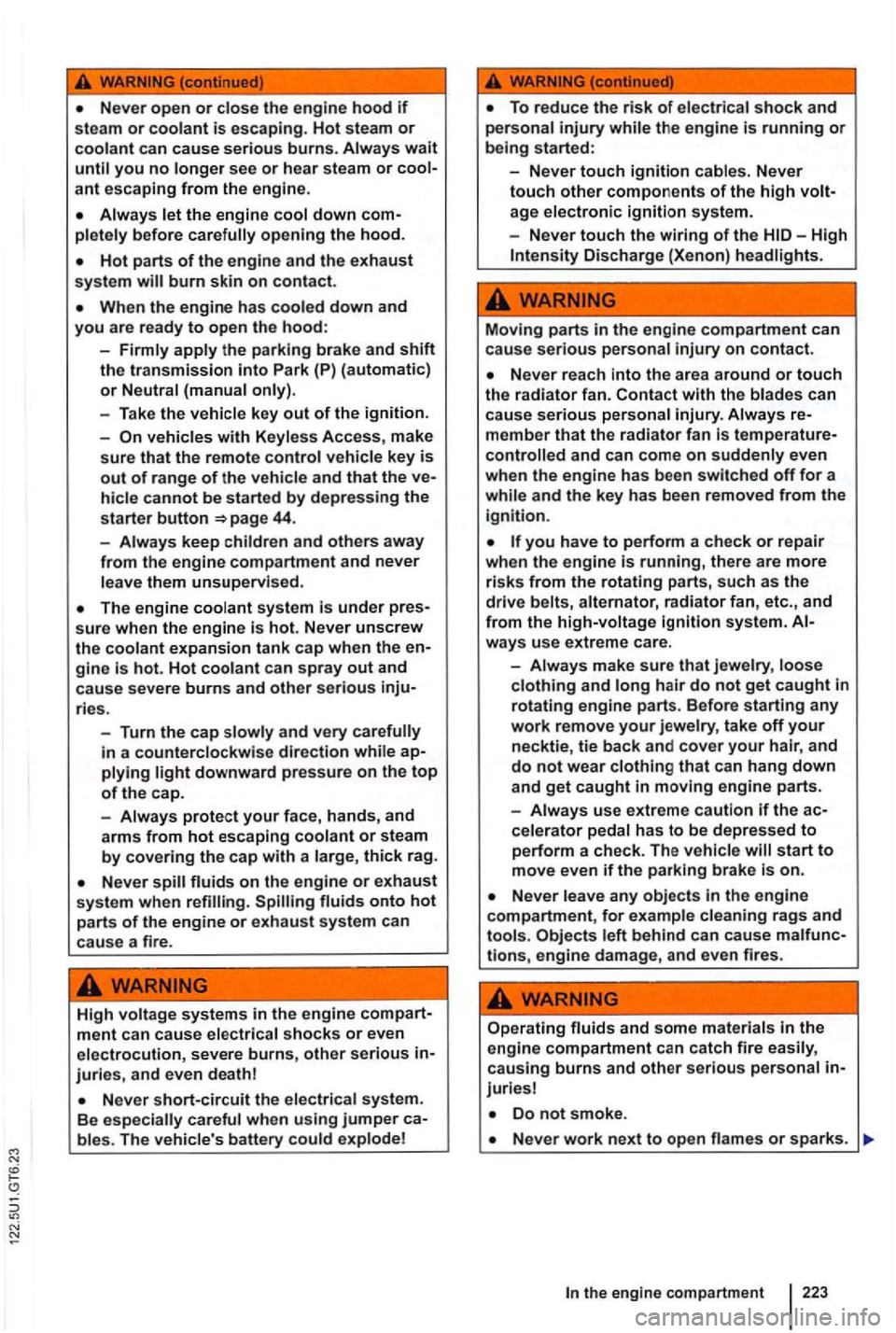
Never open or close the engine hood if To reduce th e risk of electrica l shock and steam or coolant is escaping. Hot steam or personal injury
-Never touch ignition cables. Never ant escaping from the engine. touch other components of the high
Always the eng ine down com-age electronic ignition syste m .
opening the hood.
-Never touch the wiring of the Discharge (Xenon) headlights.
system burn skin on contact.
you are read y to open the hood: Moving parts in th e engine compartment can
- Firm ly apply the parking brake a nd shift cause serious personal injury on contact. the transmission into Park (P) (automatic)
vehicles with Keyless Access, make member that the radiator fan is temperature-
s
ure that the remote contro l vehicle key is controlled and can come on sudden ly even
out of range of th e vehicle and that the ve- when the engine
has been switched off for a
hicl e cannot be started by depres sing the 44. ignition.
-
Always keep children and others away you have to perform a check or repair from the engine compartment and never when the engine is runn ing, there are more leave them unsupervised. risks from the rotating parts, such as the
hair do not get caught in
ries. rotating engine
parts. B efore starting an y
- Turn
the cap
fluids onto hot parts of the engine o r exhaust system can
cause a fire. -
Always use
extreme caution if the ac-
ce lerato r pedal has to be depressed to perform a check. The vehicle will start to move even if the parking brake i s on.
Never leave any objects in the engine compartment, for examp le cleaning rags and tools. Objects left b ehind can cause malfunc-lions, engine damage, and even fires.
High voltage sy stems in the engine com part-ment can ca use electrica l shocks or even
electrocution, severe burns, other serious in-juries, and eve n deathl
Neve r short-circuit the electrica l syste m .
B e especially ca reful when using jumper ca-
Operating fluids and some materials in the engi ne compartment can catch fire easily, causing burns an d other serious personal in-juries
Do not smoke .
b les. The
vehicle 's battery could exp lode! Never work next to open flames or sparks .
223
Page 426 of 516
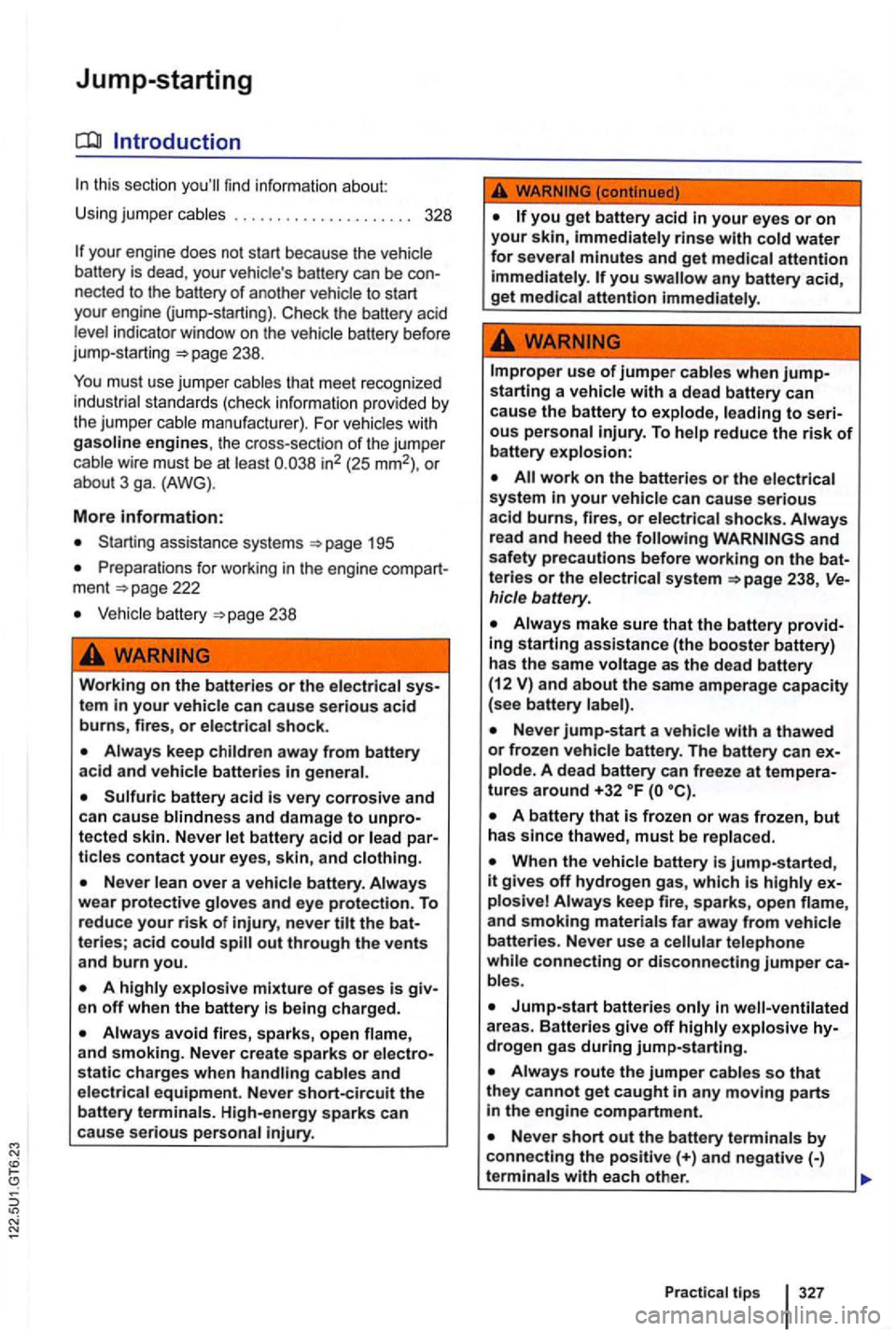
Jump-starting
this sect ion find inform atio n about:
U sing jum per cables . . . . . . . . . . . . . . . . . . . . . 328
your eng ine does not start because the
the battery acid
l evel indicator window on the vehicle battery before
jump -starting
with gasoline engines , the cross -sec tion of the jumper
cable wire must be at least
assistance systems 195
Prepara tions for worki ng i n the engine compa rt
ment 222
Vehicle battery
Working on the batterie s or the electrical syste m in your vehicle can cause serious acid burns, fires , or electrical shock.
Never lean over a vehicl e battery. Always
w ea r protective gloves and eye protection. To
r educe your risk o f injury, never tilt the bat
t e rie s; acid could spill out through the vents and burn you.
A highly explosive mixture of gases is give n off when the battery being charged.
you an y battery acid,
g et medical attention immediately .
work on the batterie s or the e lectrica l system in your vehicle can cause serious acid burns, fires, or electrical shocks. Always
read and heed the
Never jump-start a vehicle with a t hawed or frozen vehicle battery. The battery can explode. A d ead battery can freeze at tempera
tures around +32
A batt ery that is frozen or was frozen , but has since thawed, must be replaced.
Wh en the vehicle battery is jump-s ta rted ,
i t give s off hydrogen gas, which is highly ex
plosive! Always keep fire, s park s, open flame,
an d smoking mater ials far aw ay from vehicle batteries. Neve r use a telephon e while connecting or disconnecting jumper ca
bl es.
Practica l tips
Page 427 of 516
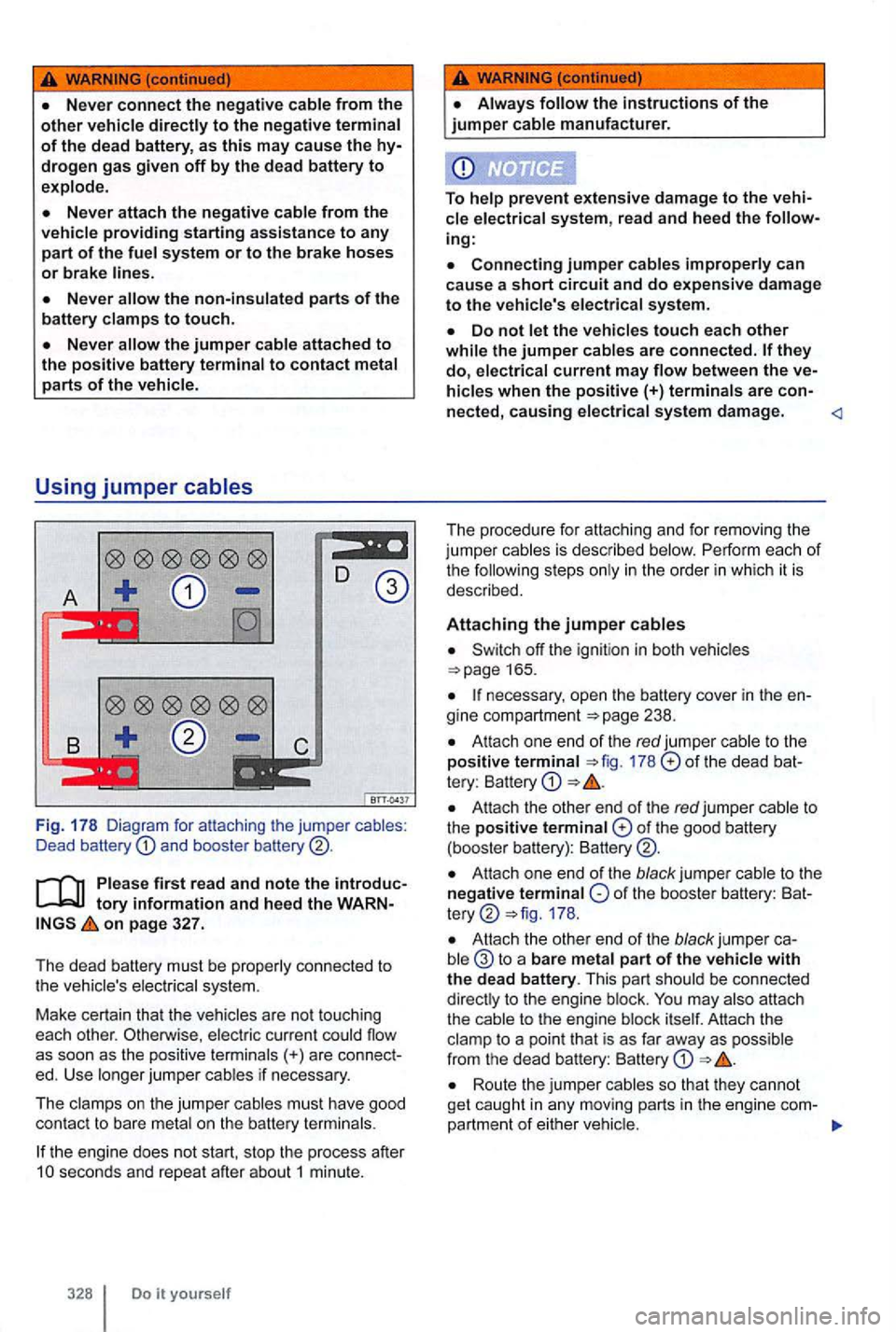
{continued)
the non-insulated parts of the
battery clamps to touch.
the jumper cable attached to the positive battery terminal to contact metal parts of the vehicle.
Using jumper cables
Fig . 17 8 Diagram for attaching the jumper cables:
Dead battery and booste r
on page 327.
The dead battery must be properly connected to
the vehicle's electr ical system .
Make ce
rtain tha t the vehicles are not touchi ng
each other. Otherwise , electric curr ent could flow
as soo n as the positive terminal
s(+) are connec t
ed. Use longer jumper cables if necessary .
Th e clamps on the jumper cables must have good
con tac t to bare metal on
the battery termina ls.
the engine does not start, stop the process after seconds and repeat after about1 minute.
cle electrical system, read and heed the
Connecting jumper cable s improperly can
ca use a short circuit and do ex pen sive dama ge to the vehicle's electrical system .
Switch off the ignition in both vehicles 165.
necessary , open the battery cover in the
At tach one end of the red jumper cable to t he
po sitive terminal 178 of the dead tery : Battery
Attach the othe r end of the red ju mper cable to the positive terminal of the good battery
(booster battery):
Atta ch one end of the black jump er of the booste r battery: 178 .
Attach the other end of the black jumper to a bare meta l part of the vehicle with the dead battery. This part shou ld be connected
dire ctly to the eng ine blo ck.
Route the jumper cables so that they cannot
ge t ca ught in any moving parts in the engine com-
partment of e ith er vehic le.
Page 428 of 516
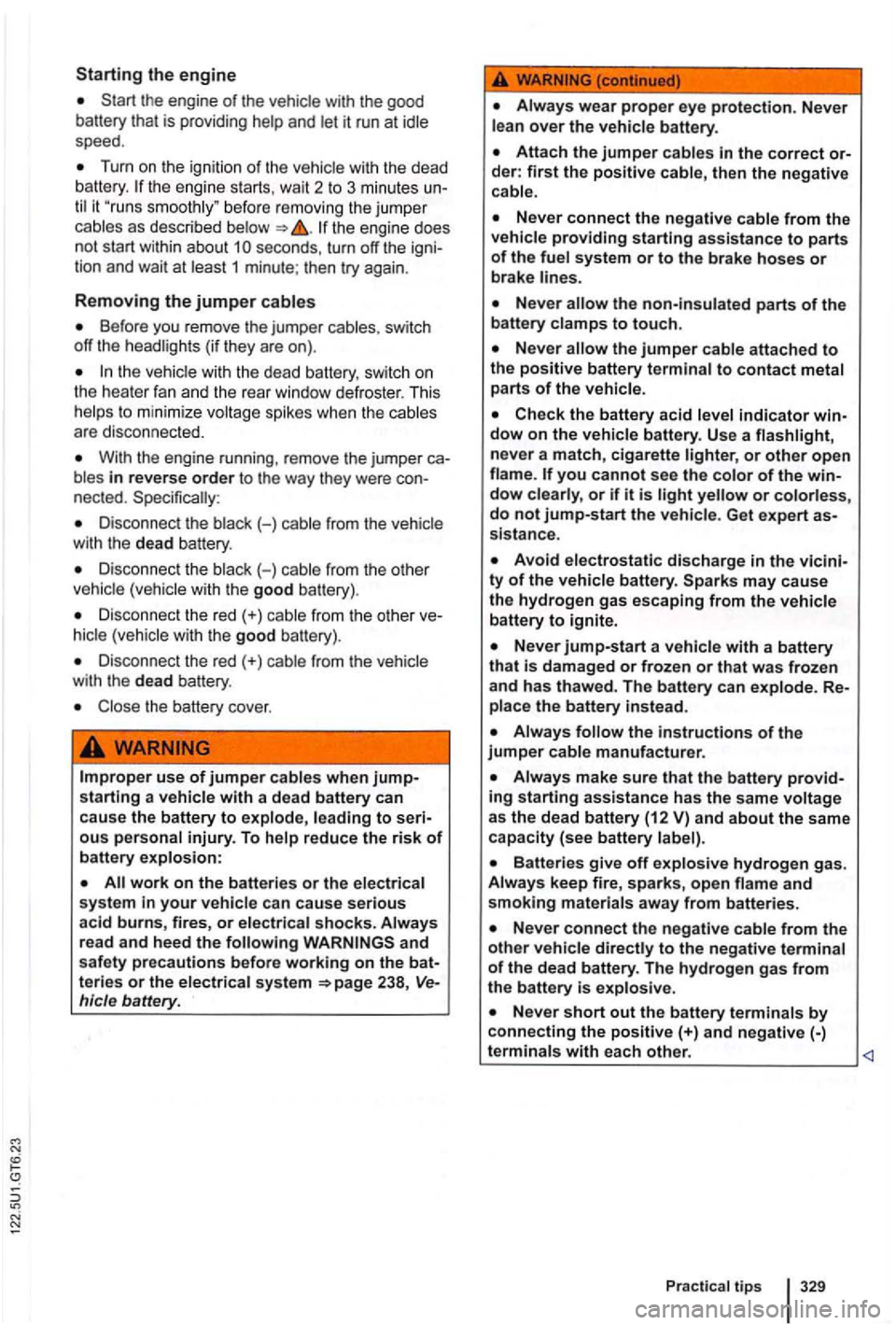
the engine
the engine of the vehicle with the good
battery that is providing help and let it run at idle
speed .
Turn on the ignition of the vehicle with the dead
b attery. the engine starts, wait 2 to 3 minutes
the engine does
not start within about seconds , turn off the tion and wait at least 1 minute ; then try again .
Removing the jumper cables
Before you remove the jumper cables. swi tch
off the headlights (if they are on) .
the vehic le with the dead batte ry , switc h on
t he heater fa n and the rea r window defroster. This
he lps
to m in im ize voltage spikes when the cables
a re disconnected.
With the engine running , remove the jumper
nected .
Disconnect the black (- ) cab le f rom the vehicle
wit h the dead battery .
Disconnec t the black (-) cable from the other
vehicle (vehicle with the good battery) .
Disconnect the red(+) cable from the other
Disconnect the red (+ ) cable from the vehicle
with the dead battery .
Close the battery cover.
Improper use of jumper cables when starting a vehicle with a dead battery can
cause the battery to explode , leading to
Always wear proper eye protection. Never
lean over the vehicle battery.
Attach the jumper cables in the correct
Never connect the negative cable from the
vehicle providing starting assistance to parts of the fuel system or to the brake hoses or brake lines.
Never
sistance.
Avoid electrostatic discharge in the may cause the hydrogen gas escaping from the vehicle battery to ignite.
Never jump-start a vehicle with a battery
that is damaged or frozen or that was frozen
and has thawed. The battery can explode.
Always the instructions of the jumper cable manufacturer.
Never connect the negati ve cable from the other vehicle directly to the negative terminal of the dead battery . The hydrogen gas from
the battery is explosive.
Never short out the battery terminals by connecting the positive(+) and negative
Practical tips 329
Page 441 of 516
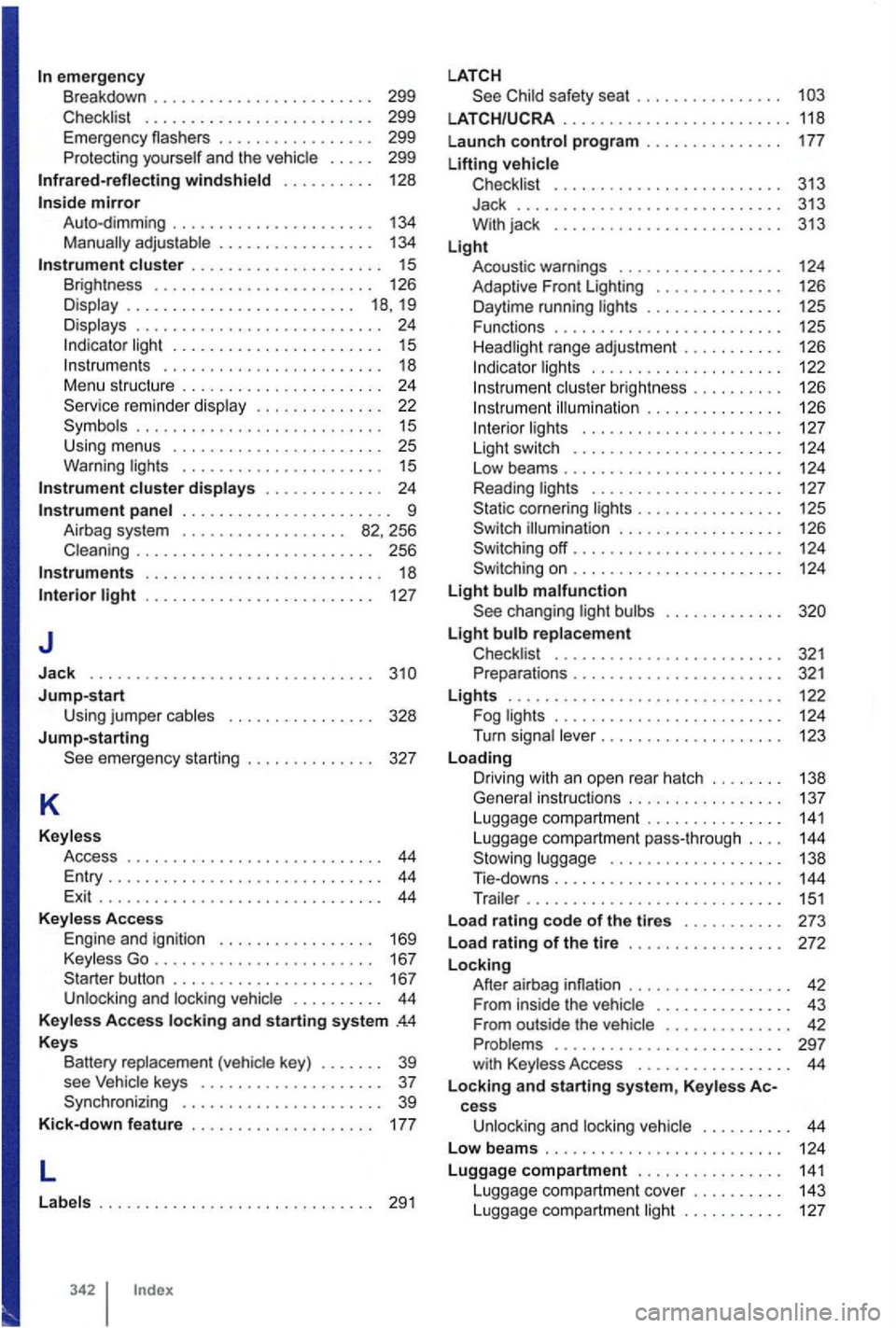
emergency Breakdown . . . . . . . . . . . . . . . . . . . . . . . . 299
Checklist . . . . . . . . . . . . . . . . . . . . . . . . . 299
Emergen cy flashers . . . . . . . . . . . . . . . . . 299
Pr otecti ng yourself and the
. . . . . 299
Infrared-ref lecting windshield . . . . . . . . . . 128
cluster . . . . . . . . . . . . . . . . . . . . . 15
Brightn ess . . . . . . . . . . . . . . . . . . . . . . . . 126
Display . . . . . . . . . . . . . . . . . . . . . . . . . 18, 19
Displays . . . . . . . . . . . . . . . . . . . . . . . . . . . 24
light . . . . . . . . . . . . . . . . . . . . . . . 15 . . . . . . . . . . . . . . . . . . . . . . . . 18 Menu structure . . . . . . . . . . . . . . . . . . . . . . 24
Service reminder display . . . . . . . . . . . . . . 22
. . . . . . . . . . . . . . . . . . . . . . . . . . . 15 Using menus . . . . . . . . . . . . . . . . . . . . . . . 25
Warning lights . . . . . . . . . . . . . . . .
cluster displays . . . . . . . . . . . . 24
. .
. . . . .
light . . . . . . .
Jump-start Using jumper cables . . . . . . . . . . . . . . . . 328 Jump-starting
. . . . . . . . . . . . . 169
Keyless Go. . . . . . . . . . . . . . . . . . . . . . . 167
Starter button . . . . . . . . . . . . . . . . . . . . . . 167
Unlocking and locking vehicle . . . . . . . . . .
44 Keyless Access locking and starting system .4.4
Keys
Battery replaceme nt (vehic le key ) . . . . . . . 39
see
. . . . . . . . . . . . 177
L
Labels .............•................ 291
safety seat . . . . . . . . . . . . . .
......................... 118
Launch
control program . . . . . . . . . . . . . . 177
Lifting vehicle Checklist . . . . . . . . . . . . . . . . . . . . . . . . . 313 Jack .....................•....... 313
With ja ck . . . . . . . . . . . . . . . . . . . . . . . . . 313
Light Acoustic warnings . . . . . . . . . . . . . . . . . . 124 Adaptive Front Lighting . . . . . . . . . . . . . . 126
Daytime running lights . . . . . . . . . . . . . . . 125
Functions . . . . . . . . . . . . . . . . .
. . . . . . . 125
Headlight range adjustment . . . . . . . . . . . 126
. . . . 122
illumination . . . . . . . . . . . . . . . 126 lights . . . . . . . . . . . . . . . . . . . . . . 127
Ligh t swi tch . . . . . . . . . . . . . . . . . . . . . . . 124
Low beams . . . . . . . . . . . . . . . . . . . . . . . . 124
Reading lights . . . . . . . . . . . . .
. . . . . . . 127
. . . . 124 Light bulb malfunction . . . .
Light bulb replacement
Checklist . . . . . . . . . . . . . . . . . . . . . . . . 321 Preparations . . . . . . . . . . . . . . . . . . . . . . 321
Lights . . . . . . . . . . . . . . . . . . . . . . . . . . . . . . . . . . . . . . 124
Turn signal lever . . . . . . . . . . . . . . . . . . . . 123
Loading Driving with an open rear hatch . . . . . . . . 138
Genera l instructions . . . . . . . . . . . . . . . . . 137
Luggage compartment . . . . . . . . . . . . . . .
141 Luggage compartment
cess
Unlocking and locking vehicle . . . . . . . . . . 44
Low beam s . . . . . . . . . . . . . . . . . . . . . . . . . 124
Luggage
compartment . . . . . . . . . . . . . . . . 141 Luggage compartm ent cover . . . . . . . . . . 143
Luggage compartment light . . . . . . . . . . . 127